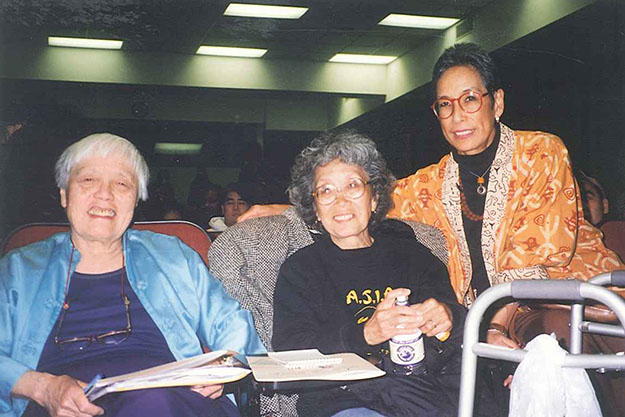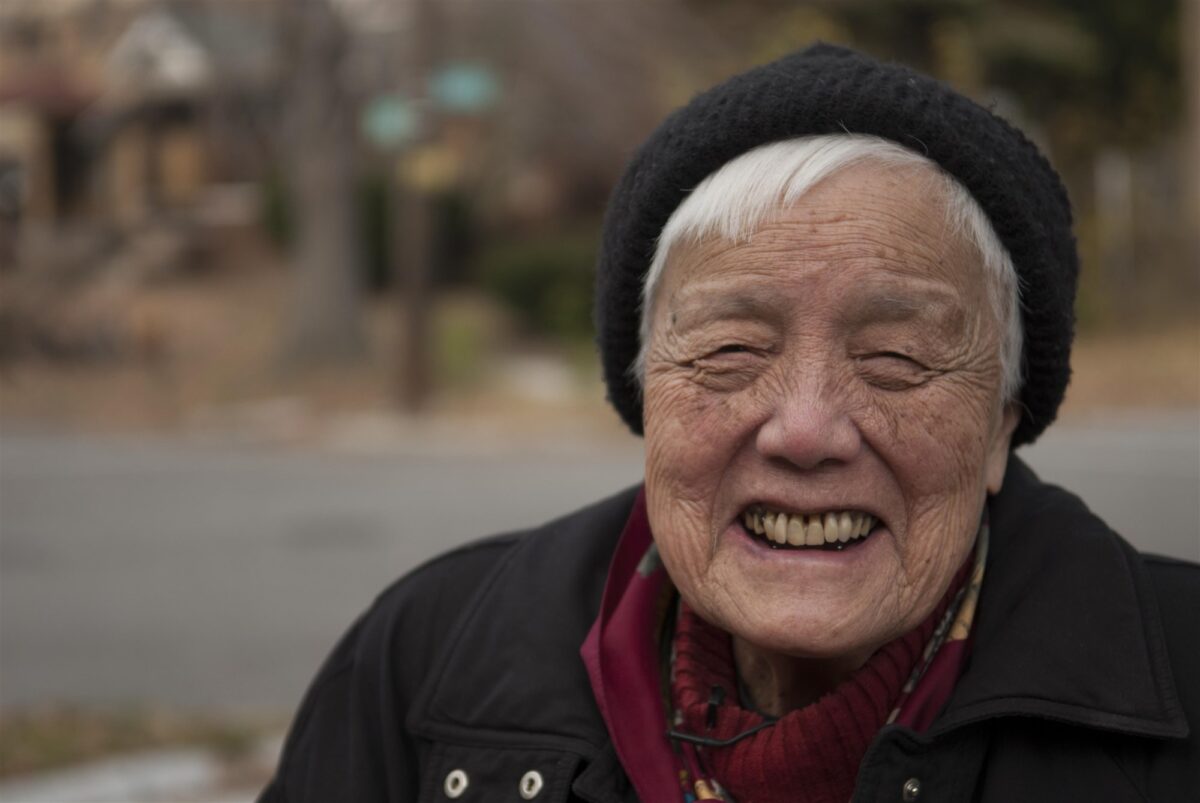By Guest Contributor: Scott Kurashige
Eight years ago amid the heat of a Detroit summer, legendary Chinese American scholar-activist Grace Lee Boggs sat in her Eastside home with a small group of Black, white, and Asian American activists to discuss the changing racial dynamics in the city and the nation. At the age of 99, she had a lifetime of experience to reflect upon. For most of her life, Grace had established her reputation as a movement organizer in the Black community, in partnership with her husband, Jimmy Boggs, a Black autoworker from the Jim Crow South.
By her eighties and nineties, however, Grace began to speak more directly to and about Asian Americans, as she did in her home on that day in the summer of 2014. “I think when you’re an Asian American, you’re not regarded as very significant,” she said. “But I think we have to change our thinking about that.”
This was, to the best of my knowledge, the final recorded address Grace made to any grouping of people before she entered hospice care. Today—June 27th, 2022, and 107 years to the day Grace Lee Boggs was born above her family’s restaurant in Providence, Rhode Island—I want to reflect on the dual challenge she presented to us in that address in 2014. Why did she choose this moment to condemn the dismissive attitude toward Asian Americans? How was she calling for us—Asian and non-Asian alike—to “change our thinking”?
“I think when you’re an Asian American, you’re not regarded as very significant, but I think we have to change our thinking about that.”
Grace Lee Boggs
“The very word ‘Asian American’ was in response to the Black Power movement,” Grace noted at the Serve the People: Asian American Movement Building Conference in 1998. “We began to see a new revolutionary identity for ourselves. We began talking about ourselves in a new way as Asian Americans. We saw ourselves as part of a Third World revolutionary movement.”
During the 1960s, the Boggses saw the Black struggle as the vanguard of the revolution. Grace immersed herself in the Black Power movement to such a degree that she once dismissed Dr. Martin Luther King as too moderate and naïve. She was nominated to run for office on the (otherwise) “all Black” Michigan Freedom Now Party slate in 1964. Six years later, she was one of the co-authors of Toni Cade Bambara’s iconic anthology, The Black Woman. A police intelligence report from this era surmised (errantly) that she probably had Chinese and African ancestry.
By the late 1970s, however, the Boggses’ assessment had changed. They argued that the advances of the Civil Rights and Black Power movements had led to the cooptation of too many Black leaders by the corporate and political establishment. While they continued to devote much of their time and energy to educating and nurturing radical activism within Detroit’s Black community, they believed that changing realities necessitated drawing people from diverse backgrounds into revolutionary movement work. By the 1980s, they were building solidarity for Indigenous peoples resisting development and displacement on Native lands, and shortly before his death in 1993, Jimmy Boggs urged in his final letter to the Detroit Free Press that “African Americans and European Americans should be thinking of how to integrate with Detroiters of Latino and Arab descent.”1Grace Lee Boggs, Living for Change: An Autobiography (Minneapolis: University of Minnesota Press, 1998), 237.
Grace also believed it was incumbent on Asian Americans to find our place within the next American revolution. We must, of course, reject model minority assimilationism and its anti-Black connotations. Like Yuri Kochiyama, Grace serves as more than an iconic model of Black-Asian solidarity, but helps us appreciate how the African American struggle for freedom opened up new possibilities for everyone.

At the same time, she believed it was incumbent on all movement organizers to recognize the distinct perspectives and contributions Asian Americans bring to the revolution. Grace was honored to have been embraced as a member of the Black community and a leader in the Black movement, though she also challenged the erasure of her identity as an Asian American woman. She saw the limitations in any quest for honorary Blackness – a venture that presents problems less pernicious than honorary whiteness but still detracts from the whole humanity of Asian Americans. And if we are not whole ourselves, how can we envision a true revolutionary advance for humanity?
[Grace] saw the limitations in any quest for honorary Blackness – a venture that presents problems less pernicious than honorary whiteness but still detracts from the whole humanity of Asian Americans. And if we are not whole ourselves, how can we envision a true revolutionary advance for humanity?
Grace’s ancestral guidance to “enlarge our thinking” is particularly poignant in these perilous times, when white nationalism, authoritarianism, heteropatriarchy, and oligarchy threaten to destroy whatever democratic prospects social movements have made possible under capitalism. In 2013, she warned us about the “increasingly desperate and dangerous” counter-revolution against civil rights and democracy by white Americans who were led to believe “the country is no longer theirs.” Grace implored us to remember how the so-called “good Germans, demoralized by their defeat in WWI, unemployment and inflation, followed Hitler into the Holocaust.”
Foreseeing how the concerted push for “anti-union, anti-women, and anti-black laws” would lead to greater assaults like the recent overturning of Roe v. Wade, she stressed the need for a new level of “cooperation” and “principled struggle” to defeat this counter-revolution. “It will take the kind of courage and persistence,” Grace declared, “that Texas State Senator Wendy Davis demonstrated when she carried out a 13-hour filibuster against a bill that would have denied women the right to choose.”
Reading Grace’s revolutionary philosophy and coming to work with her in Detroit changed the course of my life as an Asian American scholar-activist. What made her remarkable was her rare ability to reach people from all walks of life, and many whose lives she transformed were not Asian and have no connection to a university. At the same time, there are lessons to be learned from Grace’s political evolution, as she grappled with the distinct challenges she faced as a Chinese/Asian American woman on the outskirts of dominant society and sometimes the radical organizations to which she devoted her time and energy.
Asian Americans have been historically marginalized in – or outright excluded from – many spaces, even among some progressive and left activist organizations. This has created its own barriers towards informed discussion about the place Asian Americans occupy politically. Versions of model minority stereotyping fester even among progressives, who sometimes write-off Asian Americans as naturally passive and hopelessly conservative.
Allyship is essential to movement building. Yet, if Asian Americans are only allowed to see ourselves as allies of others, we risk reducing ourselves to pawns or sidekicks rather than stakeholders. Sidelining Asian Americans within the revolution over-simplifies the realities of racism and undermines possibilities for truly collaborative change.
“I think we’ve been thinking too much of only workers, white or black, as playing a part in the revolution,” Grace emphasized, as we listened in her living room eight years ago. “I think it’s really time for a change to modify and enlarge our thinking.”
There was, she noted, only one other Asian American in her college Class of 1935, whereas today it is not uncommon for Asians to make up 40 percent of university student bodies. “There are a whole lot of Asian Americans,” she stressed, “and we’ve got to really enlarge our thinking to include them in the revolution.”
“There are a whole lot of Asian Americans and we’ve got to really enlarge our thinking to include them in the revolution.”
Grace Lee Boggs
Seeing thousands of people in the Stop Asian Hate movement sharing Grace Lee Boggs quotes, making her into posters and memes, and holding her up as an Asian American activist role model can make it difficult to appreciate that Grace spent much of her life in relative obscurity. Grace grew up in the pre-World War II era, when assimilationism offered one of the only pathways to advancement for a woman of color. Despite earning a PhD, she saw limited academic job prospects owing to her race and gender. Instead, she created a new home within radical movements, eventually moving to Detroit in 1953, where her political and romantic relationship with Jimmy Boggs flourished.
As the movements in which she was involved grew, Grace often minimized her own presence, deliberately staying in the shadows of Jimmy and other charismatic leaders – a choice she viewed with ambivalence later in life. Those who knew her in the 1960s joked of her “passion for anonymity.” Grace acknowledged, “As the only Chinese American present at political meetings, I tried not to draw attention to myself and was visibly embarrassed whenever I was singled out for praise.”2Ibid, xv.
She further admitted to a “habit of self-effacement”—a habit that had notable ramifications for the public’s (mis-)perception about her. A prominent scholar-activist, for instance, once singled out Grace for backhanded praise as an “anti-racist white” ally. A constructive critic bluntly panned the first draft of Living for Change, her autobiography, surmising that Grace portrayed herself as little more than “the intelligent supplicant of two great men.”3Ibid, xv.
In the 2013 film American Revolutionary, Grace recoiled at how “demure” she appeared in those earlier pictures and videos from that era. In passages of her autobiography that have been overlooked by most reviewers, Grace recounted that she often felt isolated as an Asian American, even (or especially) within the radical organizations that Jimmy and she had founded. She cited one incident of blatant anti-Asian racism and other “ugly” attacks that made her feel she was an easy target or a scapegoat.
“Looking around me for someone to protect my back,” Grace stated, “I saw no one — which made me wonder whether for the first time in my movement experience whether comrades would have intervened if the organization had included more Asian American members.”4Ibid, 184-189.
Jimmy’s passing in 1993 challenged Grace to reassess herself and her place in the world once again. At her 60th reunion at Barnard College in 1995, when she witnessed a critical mass of Asian Americans in attendance, she was inspired to begin writing her autobiography. When she gave talks, she drew increasingly from her own lived experiences, and encouraged many activists – including many young Asian Americans – to move to Detroit and engage in the grassroots organizing that Grace championed throughout her life. The young Asian American activists she inspired, in turn, inspired Grace herself near the end of her life, and did away with the sense of racial isolation she had felt for so long.
“When Asian American visitors would come to her house,” Marcia Lee, one of those young Asian American activists, recently told me, “Grace would remind us of our importance in the movement as bridge builders.”
As I reflect on the 17 years I spent with Grace, I have come to see that final speech as the culmination of Grace’s Asian American journey. After her death, one scholar wrote about Grace’s history during the Civil Rights and Black Power era, concluding that “her Chinese American ethnicity was secondary” because she “forged a political identity that downplayed and in some respects superseded her ethnic and racial identity.”5Stephen M. Ward, In Love and Struggle: The Revolutionary Lives of James and Grace Lee Boggs (Chapel Hill: University of North Carolina Press, 2016) 170.
In telling her life story in Living for Change, however, Grace chose to foreground her identity as an Asian American woman. Her opening line read, “I consider myself blessed to have been born a Chinese American female.”6Boggs, Living for Change, xi. She saw her entire, wondrous life as a movement activist fortuitously shaped by her marginal social position based on race, ethnicity, and gender.
In telling her life story in Living for Change, however, Grace chose to foreground her identity as an Asian American woman. Her opening line read, “I consider myself blessed to have been born a Chinese American female.” She saw her entire, wondrous life as a movement activist fortuitously shaped by her marginal social position based on race, ethnicity, and gender.
As Grace met visionary Asian American activists in Detroit and around the country, she spoke more and more of the “special role” Asian Americans have to play in the revolution. Indeed, as Alex Tom took to heart after San Francisco’s Chinese Progressive Association hosted a visit by Grace in 2012, Asian Americans need to stop thinking like a “minority” when we are, in fact, part of a global majority.
How then can Asian Americans, as members of the global majority, contribute as leaders and changemakers to transform the world today? We can be certain of some conclusions Grace would draw if she were with us now:
- The wave of anti-Asian bias incidents has awakened the political consciousness of many Asian Americans. Grace would be thrilled to see thousands of Asian Americans organizing, but she would caution against falling into narrow self-interest or victimhood. The police can’t save us, and criminalization will only produce more social harm. She would be proud of the Asian American activists building multiracial solidarity and organizing around principles of mutual aid and restorative justice.
- The pandemic has exposed the selfishness and individualism at the core of both the corporate health care system and capitalism overall. We need to ground our relationships in cooperation and our livelihoods in solidarity economics. “The only way to survive,” Grace reminded us, “is by taking care of one another.”
- The rise of Trumpism , as part of the resurgence of white nationalism and fascism, has created a constitutional crisis, and exposed a broken representative democracy, a system beyond repair. We must build a new mode of self-governance from the ground up and guided by the principle of participatory democracy.
- The accelerating ecological catastrophe compels humanity to reinvent all our institutions and our entire way of life. Because of our historical and contemporary connections to Asia, Asian Americans occupy a pivotal position in the work to build global awareness and transnational alliances.
These are fundamental steps that nonetheless leave many uncertainties. In the end, the ultimate lesson of Grace’s life persists: we must always make sense of changing realities and blaze a new trail to bring humanity to a new plateau.
Scott Kurashige is the author or co-author of four books, including The Shifting Grounds of Race: Black and Japanese Americans in the Making of Multiethnic Los Angeles (2008); The Next American Revolution: Sustainable Activism for the Twenty-First Century with Grace Lee Boggs (2011); Exiled to Motown: A History of Japanese Americans in Detroit with the Detroit JACL History Project Committee (2015); and The Fifty-Year Rebellion: How the U.S. Political Crisis Began in Detroit (2017).
Learn more about Reappropriate’s guest writing program and submit your work here.


